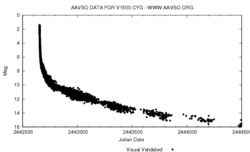| Observation data Epoch J2000.0 Equinox J2000.0 | |
|---|---|
| Constellation | Cygnus |
| Right ascension | 21h 11m 36.5810s [1] |
| Declination | +48° 09′ 01.952″ [1] |
| Apparent magnitude (V) | 1.69 to <21 [2] |
| Characteristics | |
| Variable type | Fast nova [2] + asynchronous polar [3] |
| Astrometry | |
| Proper motion (μ) | RA: −6.449(131) mas/yr [1] Dec.: −5.572(112) mas/yr [1] |
| Parallax (π) | 0.6427±0.1087 mas [1] |
| Distance | approx. 5,100 ly (approx. 1,600 pc) |
| Absolute magnitude (MV) | −10.7 (maximum) [4] to +7.8 (minimum) [5] |
| Details | |
| WD | |
| Mass | 1.20 [6] M☉ |
| Radius | 0.009 [7] R☉ |
| Luminosity | 5 [7] L☉ |
| Temperature | 54,000 [5] K |
| donor | |
| Mass | ~0.22 [8] M☉ |
| Radius | 0.42 [5] R☉ |
| Temperature | 3,000 - 5,200 [5] K |
| Other designations | |
| Nova Cyg 1975, AAVSO 2108+47, AAVSO 2108+47, Gaia DR3 2165295912482637312 [9] | |
| Database references | |
| SIMBAD | data |

V1500 Cygni or Nova Cygni 1975 was a bright nova occurring in 1975 in the constellation Cygnus. It had the second highest intrinsic brightness of any nova of the 20th century, exceeded only by CP Puppis in 1942. [10] V1500 Cygni was firstly reported by Minoru Honda of Kurashiki, Japan at 13h40m, 29 August 1975 (UT), shining at an apparent brightness of magnitude 3.0. [11] But the first discoverer in time was Kentaro Osada (August 29, 11h30m UT). [12] It had brightened to magnitude 1.7 on the next day, and then rapidly faded. It remained visible to the naked eye for about a week, and 680 days after reaching maximum the star had dimmed by 12.5 magnitudes.
Contents

It is an AM Herculis type star, consisting of a red dwarf secondary depositing a stream of material onto a highly magnetized white dwarf primary. The distance of the V1500 Cygni was calculated in 1977 by the McDonald Observatory at 1.95 kiloparsecs (6,360 light years). [13] More recently the Gaia space observatory determined a distance of approximately 5,100 light years. [1] Additionally, V1500 Cyg was the first asynchronous polar to be discovered. This distinction refers to the fact that the white dwarf's spin period is slightly different from the binary orbital period. [14] However, by 2016, x-ray observations strongly suggested that the white dwarf rotation had returned to normal synchronization with the orbit. [4]
V1500 Cygni has a remnant typical of very fast novae, consisting of some clumps and some spherically symmetric diffuse material. [15]
